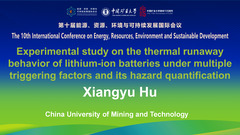Experimental study on the thermal runaway behavior of lithium-ion batteries under multiple triggering factors and its hazard quantification
ID:203
Submission ID:331 View Protection:ATTENDEE
Updated Time:2024-05-26 21:08:21
Hits:1931
Oral Presentation
Abstract
Thermal runaway (TR) is a thermal disaster in the lithium-ion battery (LIB). The TR hazard in the LIBs with different battery characteristic and under different TR triggering method is distinctive, and the absence of its systematic assessment method has long been an obstacle of the development of standardized TR inhibition. This study has investigated the TR hazard assessment parameters (HAPs) in the batteries of different rated capacity Rc and battery number N under different TR triggering method, and raised a novel method for TR hazard quantification based on these HAPs. The results show: (1) under different triggering method, the HAPs are increased with the increase of overcharging rate Cr and the decrease of heating power Ph, but not explicit with the change of punching speed Ps, and increased with Cr in most cases; (2) the quantified TR hazard HTR-q is greater in the cases of overcharging and punching, and is 1.52 times greater in the confined space under the same case in the open space. Besides, The Rc and HTR-q form a quadratic function relationship, and N and HTR-q a linear relationship. Moreover, a computing model of HTR-q is proposed with the input of, self-characteristics of battery Sc and TR triggering intensity It, which exhibits the average error of 6% approximately. This is expected to become a novel and objective method in the hazard assessment of TR in LIBs.
Keywords
Self-characteristic of the battery,Lithium-ion battery,Thermal runaway,Triggering intensity,Quantified hazard assessment
Submission Author
翔宇 胡
中国矿业大学;安全工程学院
国庆 朱
中国矿业大学;安全工程学院
通 刘
中国矿业大学;安全工程学院
少琦 崔
中国矿业大学;安全工程学院
建华 黄
中国矿业大学;安全工程学院
心同 董
中国矿业大学;安全工程学院
仙洋 郭
中国矿业大学;安全工程学院

Comment submit